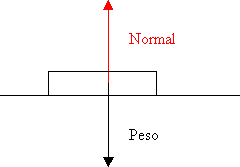The Newton's first law, also known as the law of inertia, is the first of the 3 laws of inertia. Newton's laws or laws of classical mechanics. It is a law that we could consider practically intuitive, but it is fundamental to be able to pose all the problems of mechanics and forces today.
Index
STATEMENT OF NEWTON'S FIRST LAW
"Any body will remain in its state of rest or uniform rectilinear motion if there is no force to pull it out of it".
EXPLANATION OF THE 1ST LAW OF NEWTON'S FIRST LAW
In the case of bodies at restthe Newton's first law says that it will remain stationary if there is no force to remove it from that state. The fact that an object is at rest, does not mean that there is no force acting on it, it means that the forces acting on it are not acting on it. forces at work are in equilibrium.
A practical example of this case would be that you yourself stand in balance (balancing your weight with the force exerted on you by the ground), if there is nothing pushing you (external force).

Newton's first law, which also involves the bodies in rectilinear motion. These are the bodies that move without acceleration, with a constant velocity motion.
EXAMPLES OF NEWTON'S FIRST LAW
Examples of applications of Newton's first law are practically
- All the still bodies (in equilibrium) that we see around us. Any object that you have in your house, in your office, and it is still has force equilibrium applied to it. As long as you don't modify the forces on the object, it will not move.
- If you are in constant motionIf you do not vary any force, this speed will not vary and will continue in uniform rectilinear motion. On Earth, it is practically impossible for this situation to occur, since there will always be friction from the ground, the air...
- More interesting is to find reverse situations. Situations where we would like there to be a variation of movement and there is none because there are no external forces that can break the equilibrium.
- You throw a ball, playing tennis. From the moment you hit the ball, you have defined the trajectory of the ball. If there is no variation in the forces, such as a gust of wind or hitting a wall, it is impossible to modify the motion of the ball.
- You jump from a trampoline. When you jump from a trampoline, if you are not trained to move your muscles in a vacuum, it will be practically impossible for you to vary the trajectory, as you have no additional force acting, other than the initial momentum of the trampoline.
NEWTON'S FIRST LAW EXPERIMENTS
MYTHS ABOUT NEWTON'S FIRST LAW
You will find on youtube, thousands of videos talking about Newton's first law like the law of inertia. When you remove something very quickly and the object on top of it doesn't move. These videos called "inertia" do not correspond to Newton's first law, but to the Quantity of Motion and Momentum. According to the law of momentum: a relatively high force applied for a very small time generates such a large amount of motion that any existing frictional force becomes negligible. In this video we explain it to you:
IMPORTANCE OF NEWTON'S FIRST LAW
Newton's first law, like the other two, is the basis of all problem solving in classical mechanics. The 3 Newton's laws are 3 very important laws of classical mechanics. It is necessary to understand and know these laws well in order to solve any problem in modern mechanics.
NEWTON'S LAWS
See the Newton's laws:
